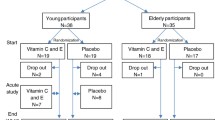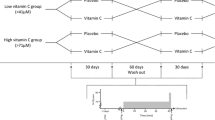Abstract
Background and aims: Aerobic endurance exercise enhances antioxidant defenses and improves the physical performance of older adults. However, the combined effect on physical performance of exercise and an antioxidant such as vitamin E has not been investigated. The purpose of this study was to evaluate the effects of six months of vitamin E supplementation and supervised aerobic training on physical performance and body composition in sedentary older adults. Methods: Fifty-seven adults, whose average age was 71.5±7.5 years, were randomly assigned to an exercise (E), exercise-vitamin (EV), control (C) or vitamin (V) group, and were evaluated before, halfway through, and after training. The dose of vitamin E was 900 IU/day. The training program comprised three sessions of walking exercise per week, at an intensity of 70% of heart rate reserve. Results: In the E and EV groups, the training program significantly reduced (p<0.016 for each) body weight and body mass index (BMI), and improved performance in the 6-min walk, chair stand, arm curl, and back scratch tests. Performance on the 6-min walk test improved in E and EV, but decreased in the V group. Performance on the chair stand test increased in the EV and E groups, but decreased in the V and C groups. Body weight and BMI decreased more in the EV group than in the C and V groups (p<0.016). Conclusions: Six months of vitamin E supplementation has no additive effect beyond that of aerobic training on indices of physical performance and body composition in older sedentary adults.
Similar content being viewed by others
References
Guralnik JM, Simonvick EM, Ferrucci L et al. A short physical performance battery assessing lower extremity function: association with self-reported disability and prediction of mortality and nursing home admission. J Gerontol A Biol 1994; 49: M85–94.
Karmisholt K, Gyntelberg F, Gotzsche PC. Physical activity for primary prevention of disease. Dan Med Bull 2005; 52: 86–9.
Selamoglu S, Turgay F, Kayatekin BM, Gonenç S, Islegen C. Aerobic and anaerobic training effect on the antioxidant enzymes of the blood. Acta Physiol Hung 2000; 87: 267–73.
Fatouros IG, Jamurtas AZ, Villiotou V et al. Oxidative stress responses in older men during endurance training and detraining. Med Sci Sport Exerc 2004; 36: 2065–72.
Mendoza-Nüñez VM, Ruiz-Ramos M, Sánchez-Rodríguez MA, Retana-Ugalde R, Muñoz-Sánchez JL. Aging-related oxidative stress in healthy humans. Tohoku J Exp Med 2007; 213: 261–8.
Rousseau AS, Margaritis I, Arnaud J, Faure H, Roussel AM. Physical activity alters antioxidant status in exercising elderly subjects. J Nutr Biochem 2006; 17: 463–70.
Toraman NF, Erman A, Agyar E. Effects of multicomponent training on functional fitness in older adults. J Aging Phys Activ 2004; 12: 538–53.
Evans WJ. Vitamin E, vitamin C, and exercise. Am J Clin Nutr 2000; 72 (Suppl. 2): 647S–52.
McBride JM, Kraemer WJ. Free radicals, exercise and antioxidants. J Strength Cond Res 1999; 13: 175–83.
Cherubini A, Martin A, Andres-Lacueva C et al. Vitamin E levels, cognitive impairment and dementia in older persons: the InCHIANTI study. Neurobiol Aging 2005; 26: 987–94.
Cesari M, Pahor M, Bartali B et al. Antioxidants and physical performance in elderly persons: the Invecchiare in Chianti (InCHIANTI) study. Am J Clin Nutr 2004; 79: 289–94.
Semba RD, Blaum C, Guralnik JM, Moncrief DT, Ricks MO, Fried LP. Carotenoid and vitamin E status are associated with indicators of sarcopenia among older women living in the community. Aging Clin Exp Res 2003; 15: 482–7.
Galan P, Preziosi P, Monget AL et al. Effects of trace element and/or vitamin supplementation on vitamin and mineral status, free radical metabolism and immunological markers in elderly long-term-hospitalized subjects. Geriatric Network MIN. VIT. AOX. Int J Vitamin Nutr Res 1997; 6: 450–60.
Ble A, Cherubini A, Volpato S et al. Lower plasma vitamin E levels are associated with the frailty syndrome: the InCHIANTI study. J Gerontol A Biol Sci Med Sci 2006; 61: 278–83.
Andriollo-Sanchez M, Hininger-Favier I, Meunier N et al. Age-related oxidative stress and antioxidant parameters in middle-aged and older European subjects: the ZENITH study. Eur J Clin Nutr 2005; 59 (Suppl. 2): S58–62.
Jessup JV, Horne C, Yarandi H, Quindry J. The effects of endurance exercise and vitamin E on oxidative stress in the elderly. Biol Res Nurs 2003; 5: 47–55.
Sacheck JM, Milbury PE, Cannon JG, Roubenoff R, Blumberg JB. Effect of vitamin E and eccentric exercise on selected biomarkers of oxidative stress in young and elderly men. Free Radic Bio Med 2003; 34: 1575–88.
Meydani M, Evans WJ, Handelman G et al. Protective effect of vitamin E on exercise-induced oxidative damage in young and older adults. Am J Physiol 1993; 264: R992–8.
Fanò G, Mecocci P, Vecchiet J et al. Age and sex influence on oxidative damage and functional status in human skeletal muscle. J Muscle Res Cell M 2001; 22: 345–51.
Güngen C, Ertan E, Eker E, Yasar R, Engin F. The Standardised Mini Mental State Examination in Turkish. Proceedings of the Ninth Congress of the International Psychogeriatric Association. Int Psychogeriatr 1999; 11 (Suppl. 1): 78.
Voorrips LE, Ravelli ACJ, Dongelmans PCA, Deurenberg P, Staveren WAV. A physical activity questionnaire for the elderly. Med Sci Sport Exerc 1991; 23: 974–9.
Yesevage JA, Brink TL, Rose TL et al. Development and validation of a geriatric depression screening scale: a preliminary report. J Psychiatr Res 1983; 17: 37–49.
Desai ID. Vitamin E analysis methods for animal tissues. Method Enzymol 1984; 105: 138–47.
Rikli RE, Jones CJ. Senior fitness test manual. Champaign, IL: Human Kinetics, 2001.
Rikli RE, Jones CJ. Development and validation of a functional fitness for community-residing older adults. J Aging Phys Activ 1999; 7: 129–61.
Wilmore JH, Costill DL. Physiology of sports and exercise. Champaign, IL: Human Kinetics, 1994.
American College of Sports Medicine. ACSM Position Stand on Exercise and Physical Activity for Older Adults. Med Sci Sports Exerc 1998; 30: 992–8.
Cruzat VF, Rogero MM, Borges MC, Tirapegui IJ. Current aspects about oxidative stress, physical exercise and supplementation. Rev Bras Med Esporte 2007; 13: 336–42.
Aslan D. Klinik Kimyada Temel Ilkeler. 1st Ed. Ankara: Palme Yayincilik, 2005 (Turkish translation of Tietz Textbook of Clinical Chemistry and Molecular Diagnostics. In Burtis CA, Ashwood ER, Bruns DE, eds.).
Cao G, Prior RL. Comparison of different analytical methods for assessing total antioxidant capacity of human serum. Clin Chem 1998; 44: 1309–15.
Lord SR, Menz HB. Physiologic, psychologic, and health predictors of 6-minute walk performance in older people. Arch Phys Med Rehabil 2002; 83: 907–11.
White E, Kristal AR, Shikany JM et al. Correlates of serum α- and γ-tocopherol in the Women’s Health Initiative. Ann Epidemiol 2001; 11: 136–44.
Wallstrom P, Wirfalt E, Lahmann PH, Gullberg B, Janzon L, Berglund G. Serum concentrations of β-carotene and α-tocopherol are associated with diet, smoking, and general and central adiposity. Am J Clin Nutr 2001; 73: 777–85.
Grolier P, Boirie Y, Levadoux E et al. Age-related changes in plasma lycopene concentrations, but not in vitamin E, are associated with fat mass. Br J Nutr 2000; 84: 711–6.
Switzer BR, Atwood JR, Strark AH et al. Plasma carotenoid and vitamins A and E concentrations in older African American women after wheat bran supplementation: Effects of age, body mass and smoking history. J Am Coll Nutr 2005; 24: 217–26.
Meydani M, Cohn JS, Macauley JB, McNamara JR, Blumberg JB, Schaefer EJ. Postprandial changes in the plasma concentration of α- and γ-tocopherol in human subjects fed a fat-rich meal supplemented with fat-soluble vitamins. J Nutr 1989; 119: 1252–8.
Hayes KC, Pronczuk A, Liang JS. Difference in the plasma transport and tissue concentration of tocopherols and tocotrienols: observations in humans and hamsters. Proc Soc Exp Biol Med 1993; 202: 353–9.
Mooradian AD, Haas MJ, Wehmeier KR, Wong NCW. Obesity-related changes in high-density lipoprotein metabolism. Obesity 2008; 16: 1152–60.
Toraman NF. Obesity and sports. In Keller K, ed. Encyclopedia of Obesity. Thousand Oaks, CA, USA: SAGE Publications Inc. 2008.
Hinkle DE, Wiersma W, Jurs SG. Applied statistics for the behavioral sciences. Boston: Houghton Mifflin, 1988.
Author information
Authors and Affiliations
Corresponding author
Rights and permissions
About this article
Cite this article
Nalbant, Ö., Tokta§, N., Füsun Toraman, N. et al. Vitamin E and aerobic exercise: effects on physical performance in older adults. Aging Clin Exp Res 21, 111–121 (2009). https://doi.org/10.1007/BF03325218
Received:
Accepted:
Published:
Issue Date:
DOI: https://doi.org/10.1007/BF03325218




